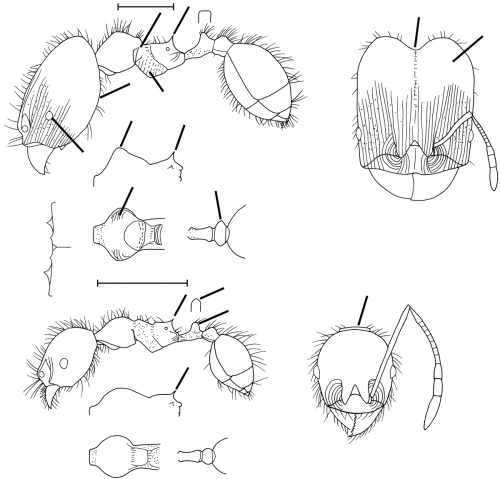Pheidole superba
| Pheidole superba | |
|---|---|
| Scientific classification | |
| Kingdom: | Animalia |
| Phylum: | Arthropoda |
| Class: | Insecta |
| Order: | Hymenoptera |
| Family: | Formicidae |
| Subfamily: | Myrmicinae |
| Tribe: | Attini |
| Genus: | Pheidole |
| Species: | P. superba |
| Binomial name | |
| Pheidole superba Wilson, 2003 | |
The Barro Colorado series was collected by Diana E. Wheeler from a bat roost.
Identification
See the description in the nomenclature section.
Keys including this Species
Distribution
Known from the type locality, as well as from Barro Colorado Island, Panama. (Wilson 2003)
Latitudinal Distribution Pattern
Latitudinal Range: 8.166667° to 8.166667°.
| North Temperate |
North Subtropical |
Tropical | South Subtropical |
South Temperate |
- Source: AntMaps
Distribution based on Regional Taxon Lists
Neotropical Region: Colombia (type locality), Panama.
Distribution based on AntMaps
Distribution based on AntWeb specimens
Check data from AntWeb
Countries Occupied
| Number of countries occupied by this species based on AntWiki Regional Taxon Lists. In general, fewer countries occupied indicates a narrower range, while more countries indicates a more widespread species. |

|
Estimated Abundance
| Relative abundance based on number of AntMaps records per species (this species within the purple bar). Fewer records (to the left) indicates a less abundant/encountered species while more records (to the right) indicates more abundant/encountered species. |

|
Biology
Castes
Nomenclature
The following information is derived from Barry Bolton's Online Catalogue of the Ants of the World.
- superba. Pheidole superba Wilson, 2003: 762, figs. (s.w.) COLOMBIA.
Unless otherwise noted the text for the remainder of this section is reported from the publication that includes the original description.
Description
Similar in various traits to Pheidole amata, Pheidole ambigua, Pheidole celaena, Pheidole fera, Pheidole germaini, Pheidole peruviana, Pheidole rutilana, Pheidole schwarzmaieri, Pheidole and Pheidole vomer, differing as follows.
Major: large, dark reddish to blackish brown; eye small; humerus prominently raised in dorsal-oblique view as a large equilateral triangle; in side view, venter of head strongly convex and dorsum weakly so, with the head as a whole tapering conspicuously to the occiput; in full-face view, head subrectangular, with deep occipital cleft; posterior half of dorsal head surface smooth and shiny, anterior half carinulate, with no rugoreticulum; lower half of mesopleuron, humeri, and parts of mesonotum and propodeal dorsa carinulate, rest of mesosoma smooth and shiny; propodeal spines long and slender; postpetiole from above elliptical, with angulate margins.
Minor: yellow; occiput only slightly narrowed but with nuchal collar; apex of petiolar node strongly and broadly convex; spines short and directed backward; head and body mostly smooth and shiny.
MEASUREMENTS (mm) Holotype major: HW 1.84, HL 2.16, SL 0.86, EL 0.20, PW 0.84. Paratype minor: HW 0.62, HL 0.66, SL 0.74, EL 0.10, PW 0.40.
COLOR Major: head dark reddish brown, rest of body blackish brown, appendages medium reddish brown.
Minor: dark yellow.
Figure. Upper: holotype, major. Lower: paratype, minor. Scale bars = 1 mm.
Type Material
COLOMBIA: Pueblito, on southern boundary of Tayrona Park, 250 m, col. Charles Kugler. Museum of Comparative Zoology
Etymology
L superba, splendid, superior, referring to the larger, strikingly dark, shiny body of major.
References
- Wilson, E. O. 2003. Pheidole in the New World: A dominant, hyperdiverse ant genus. Harvard University Press, Cambridge, MA. (page 762, fig. major, minor described)
References based on Global Ant Biodiversity Informatics
- Fernández, F. and S. Sendoya. 2004. Lista de las hormigas neotropicales. Biota Colombiana Volume 5, Number 1.
